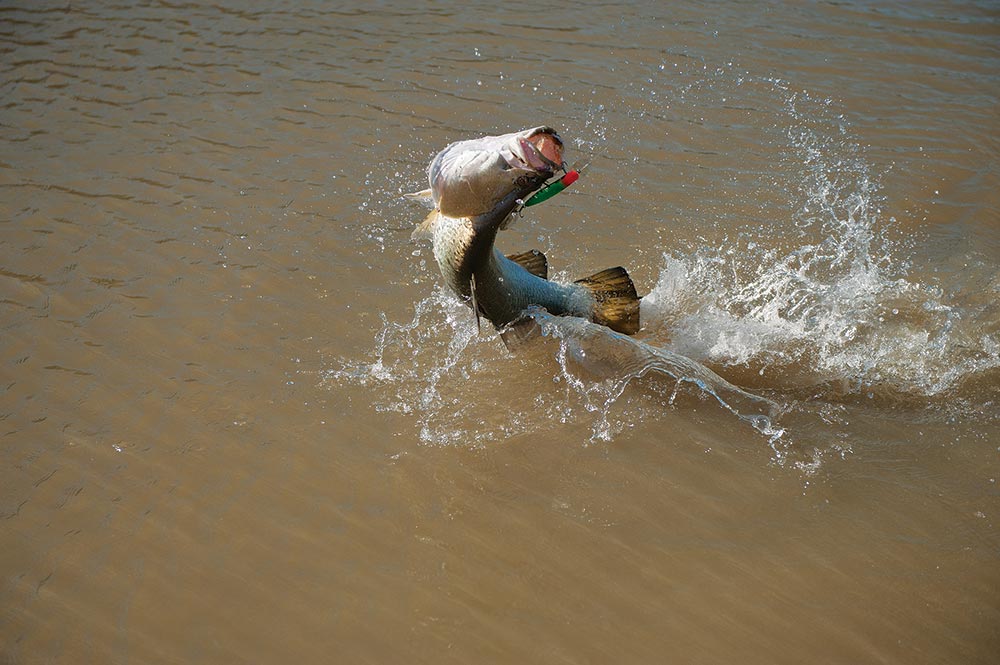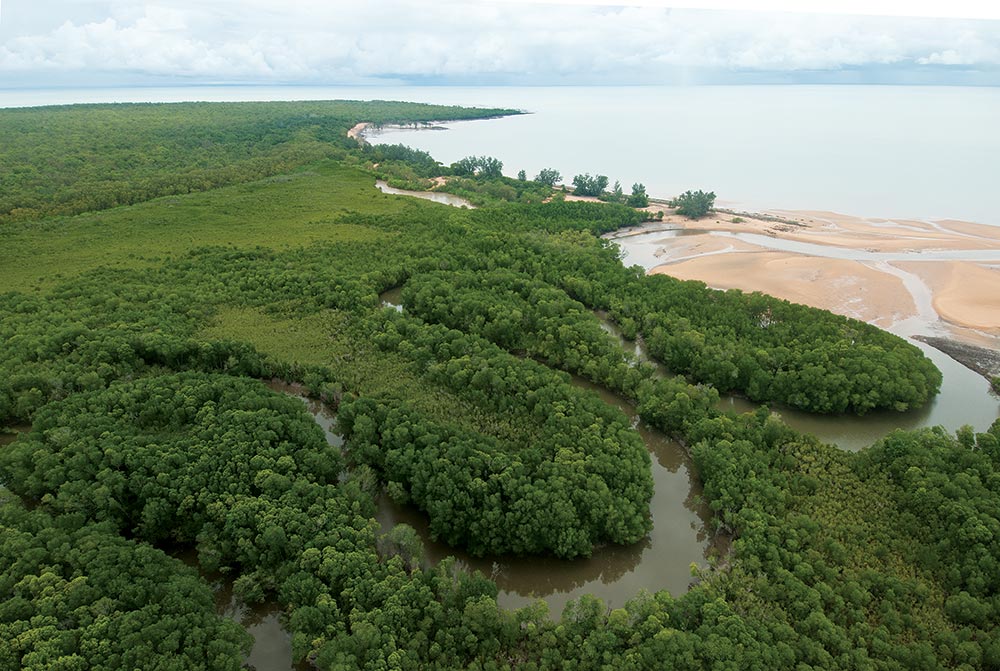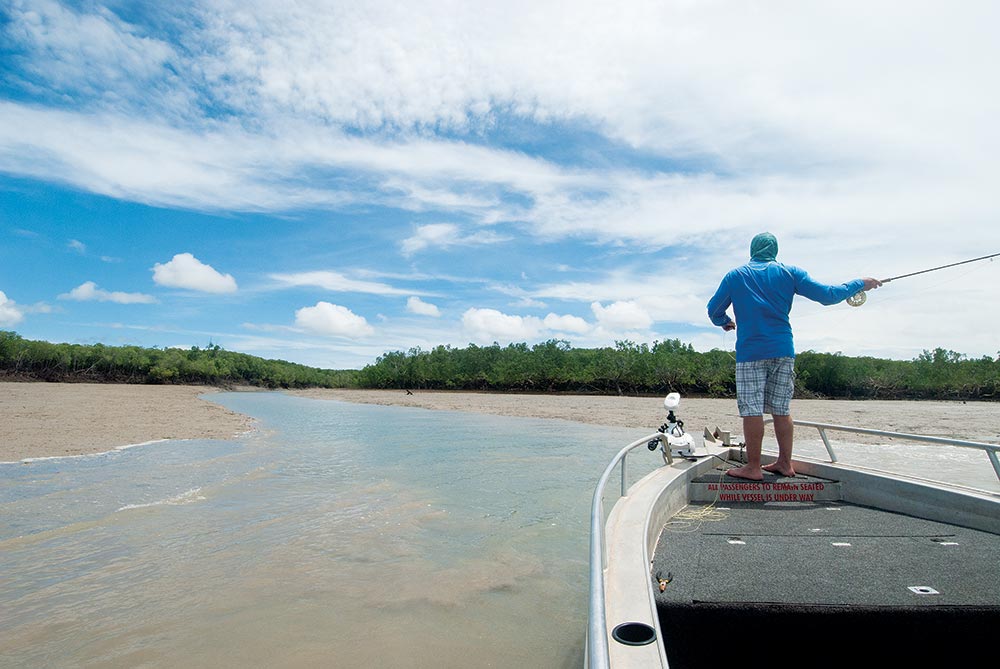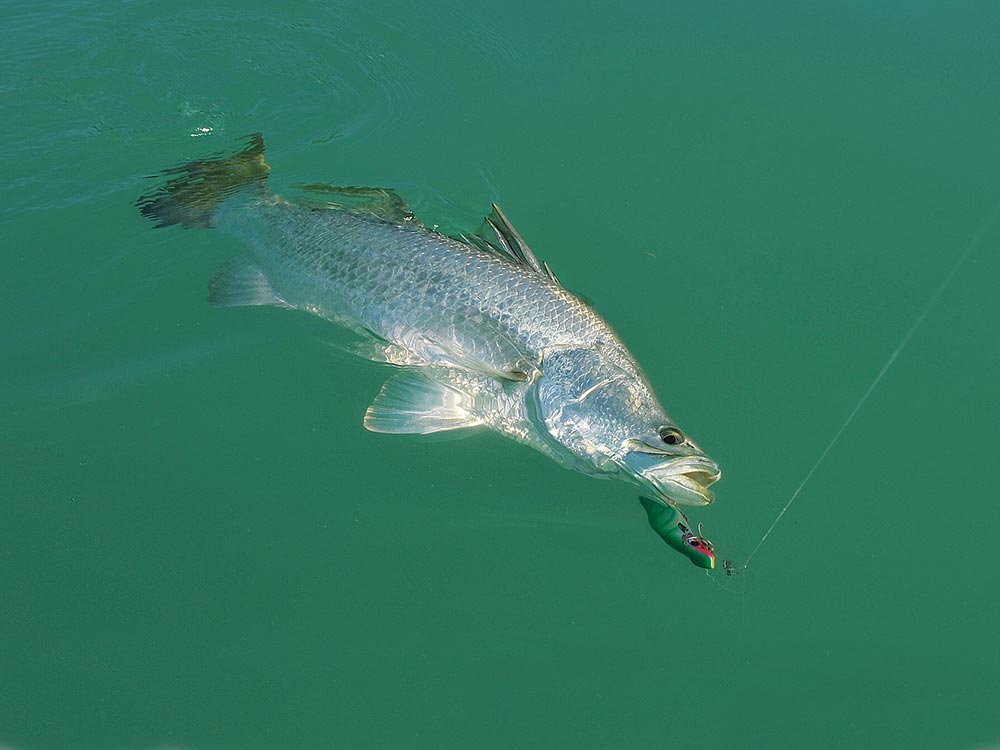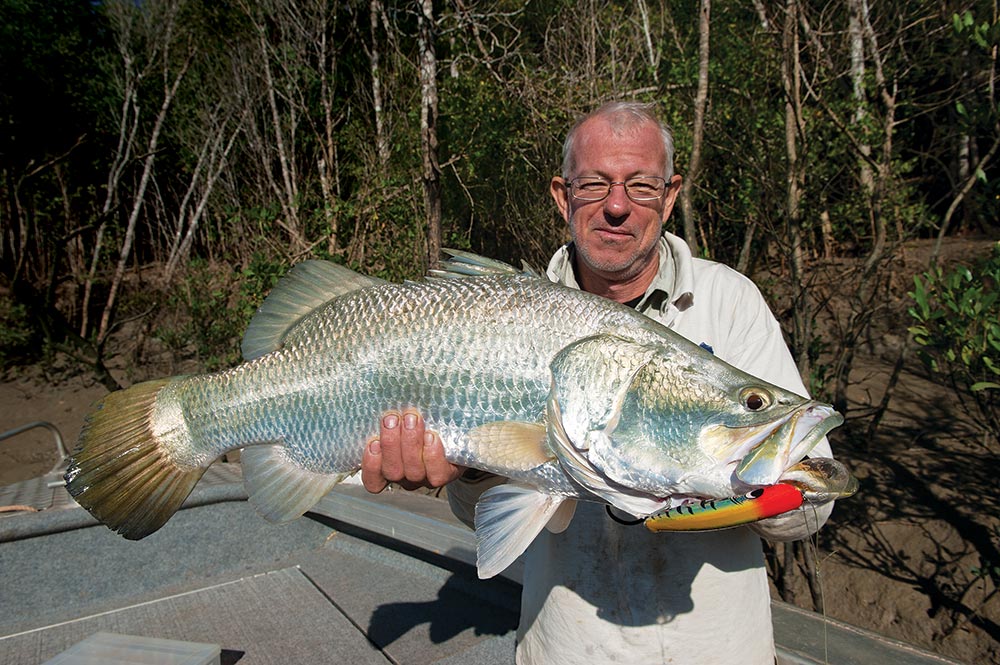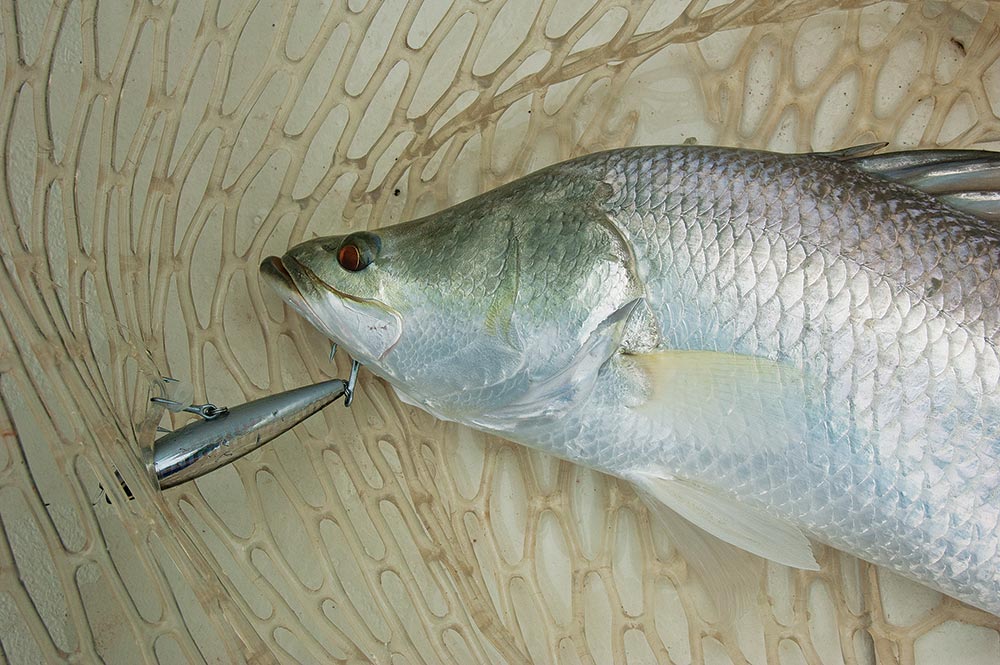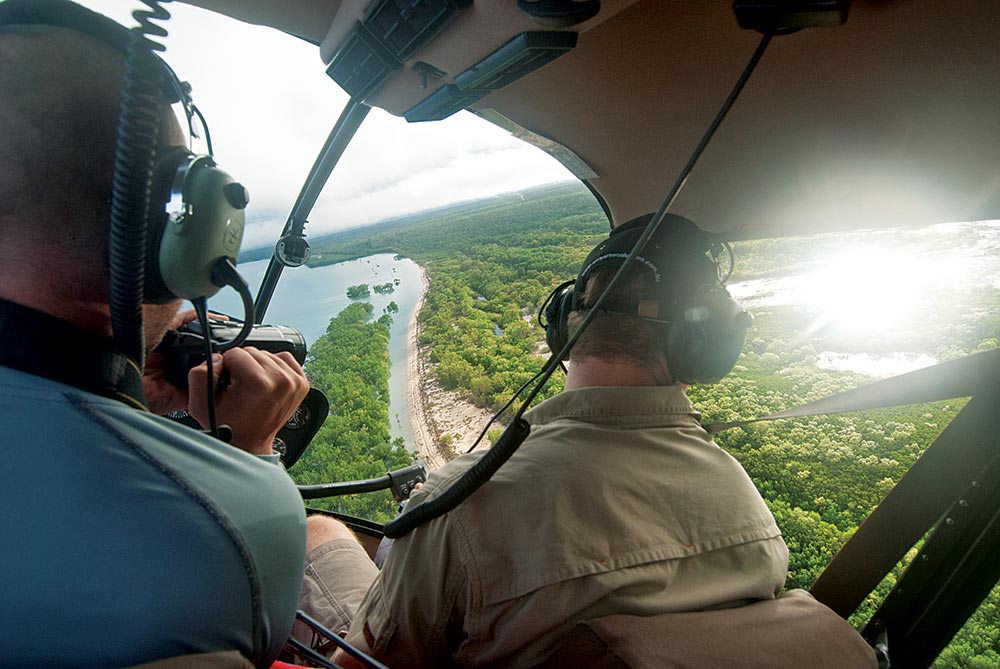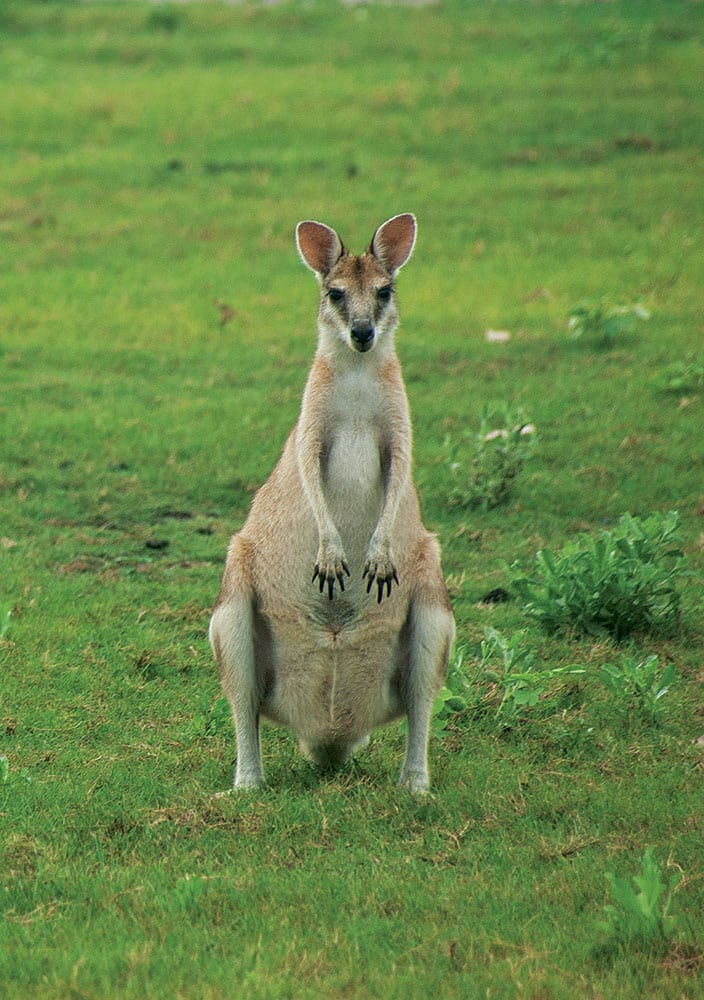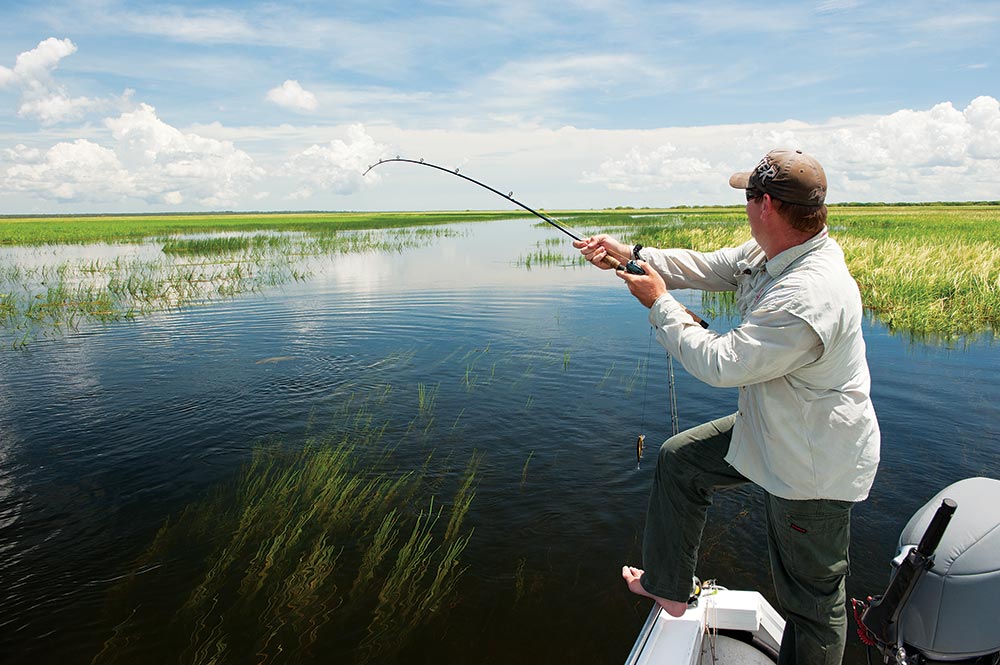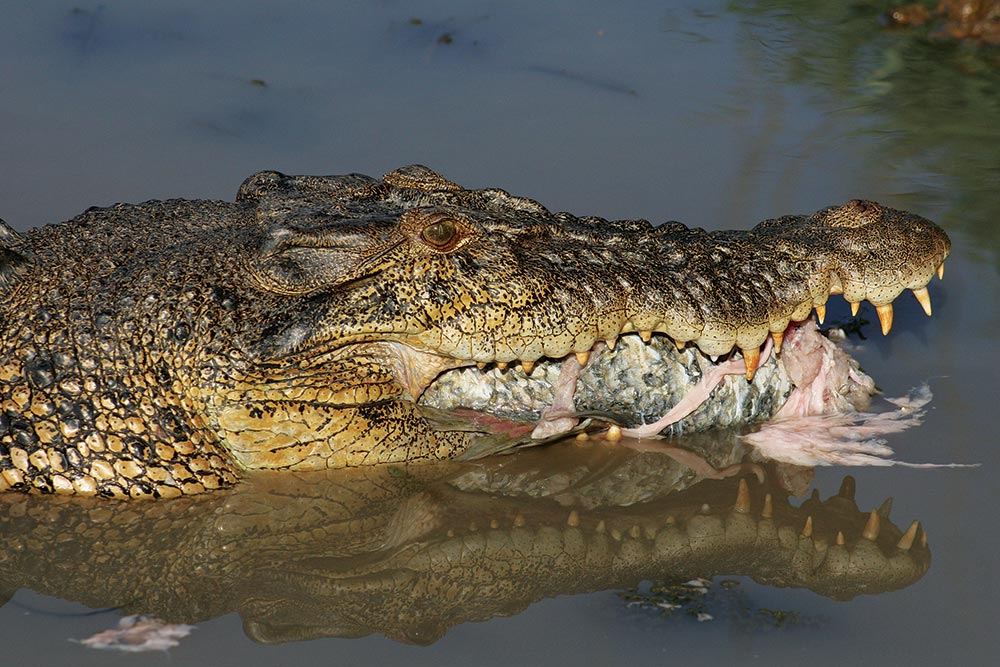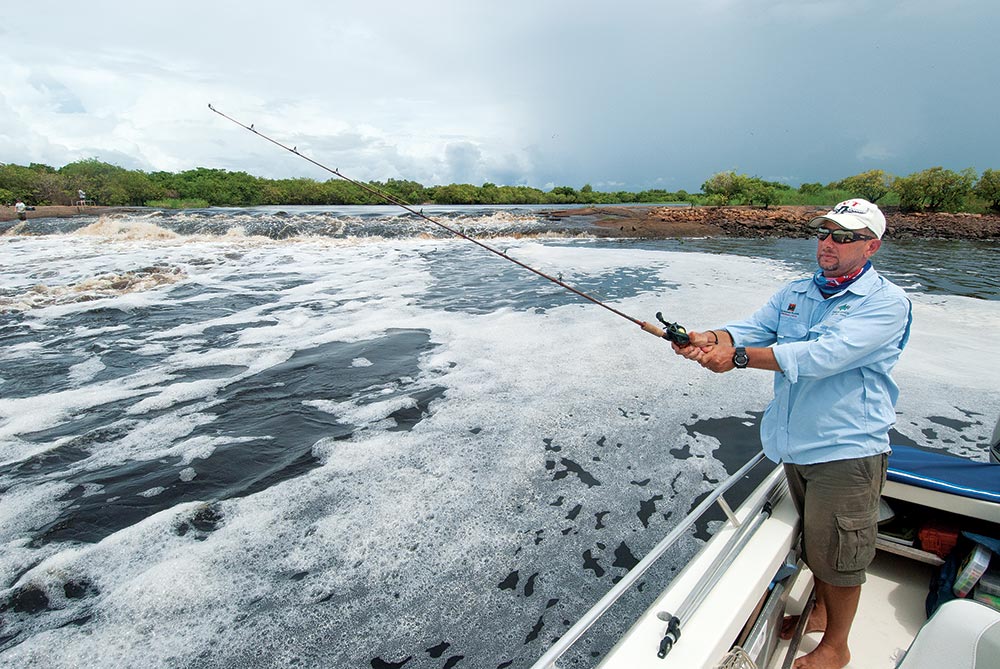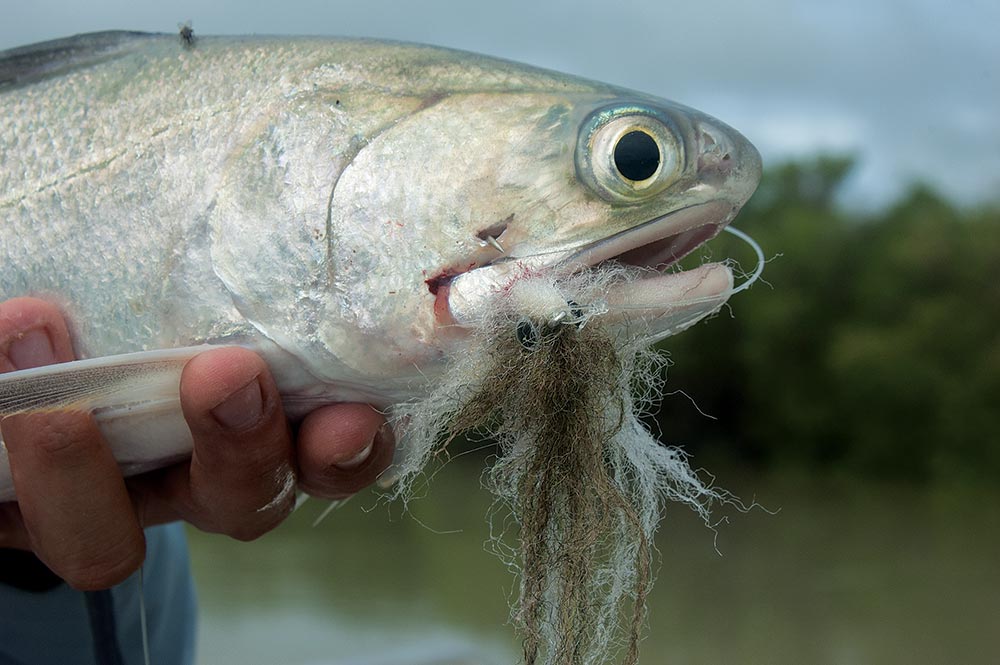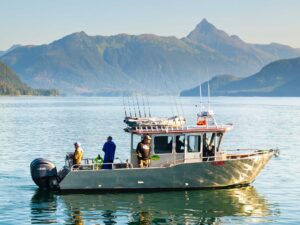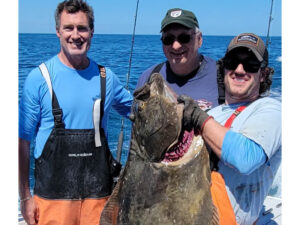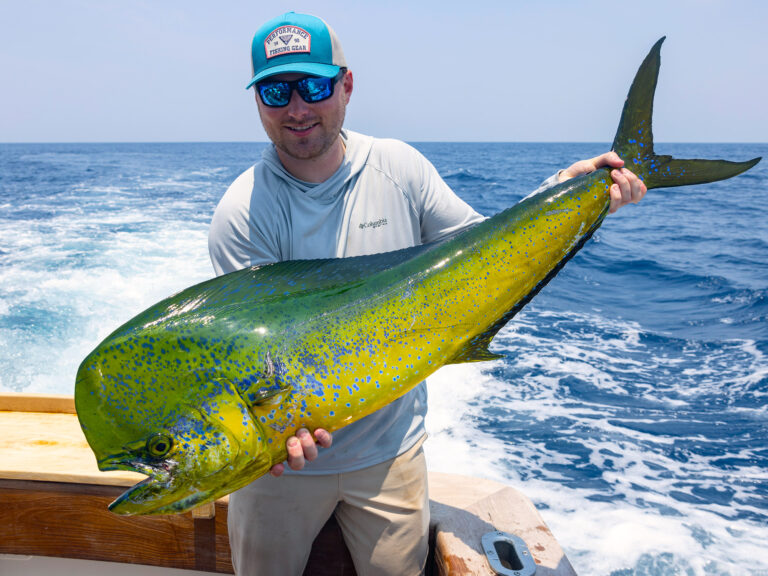Many men go fishing all of their lives without knowing that it is not fish they are after. — Henry David Thoreau (paraphrased)
1956. That’s the last time Australia’s Northern Territory (NT) experienced as “dry” a wet season as it did in 2013. The weather this past February and March threw a whopper of a jinx on my first-ever adventure to target the region’s famed barramundi, during the legendary runoff season. But when you plan such a far-flung excursion, there’s no “maybe.” There’s no postponement once the airfare is purchased. Instead, you step into a decidedly foreign world in faith, and you prepare … for revelation.
Destination Darwin
The late-March sun burned summer hot in the southern hemisphere; not what I had left behind in chilly North America. Time also had twisted. I left on a Saturday, and here it was Monday, after about 18 hours of flying.
Once we arrived at the hotel, Skycity Darwin, I left my traveling and fishing companion John Frazier, former editor of Fly Fishing in Salt Waters, to unpack and assemble his fly tackle. I quickly checked my three travel rods, then slipped into a giant swimming pool just below the deck off my room. Floating in the fresh water, I considered our four-day fishing schedule:
Day 1: Sight-fishing barramundi in Bynoe Harbour with Capt. Ben Currell of Vision Sport Fishing charters. Bynoe spans a system of bays and mangrove marshes west of Darwin.
Day 2: Heli-fishing with Airborne Solutions, dropping onto remote beaches to fish the estuaries and river mouths north and east of Darwin.
Days 3 and 4: Fishing farther east, near Kakadu National Park, with Bamurru Plains resort, at the edge of the Mary River floodplains.
I could scarcely believe my luck — never mind the dire dry predictions.
Silver in Sight
Currell picked us up the next morning in the dark. We rode for about an hour down progressively smaller roads to a plain-concrete ramp at the edge of nowhere.
Currell launched his aluminum center-console, and we boarded quickly — keeping a wary eye out for the region’s other famous resident: the saltwater crocodile. At our first drop, Currell brought out some shallow-diving lures for us to fish on 12- to 15-pound tackle, while Frazier picked one of the infinite fluffy fly things he had tied before the trip. Steering his bow-mounted trolling motor mere feet from the mangrove roots, Currell peered into the milky-looking water.
“The barra will let us get up to about 6 feet away from them, provided we’re not banging around too much,” Currell explained, his Aussie vowels sliding long and flat. “Use short, hard twitches, and suspend the lure in between.”
Frazier and I — used to spotting snook among the -mangroves — were surprised to see our first barra tail up and poised vertically in a narrow space between roots, its bright silver body tipped by a black tail. “Their fins go black rather than gray or yellow when they feed,” Currell says.
Water flowing among the roots seemed almost stagnant compared with the rush of the main channel. Tides change anywhere from 5 to 23 feet four times a day in the NT, so the locations Currell fishes remain wholly and completely dependent on tide.
Whenever he saw a fish, Currell flipped his MJ Twitch bait just ahead of the barra and popped the plug; at first, he had no takers. He used a 4-foot leader of 40-pound -fluorocarbon to the braided main line.
Most Aussies don’t fish like this, Currell told us. Most generally troll for barramundi. With a fly angler on the boat, trolling wasn’t an option — I was secretly glad for that.
We crept into the mangroves again and heard a sullen smack well back in the trees. We saw several small, amusing fishes — archerfish that spit water at their prey and mudskippers that crawl about on land. Currell hooked and released a mangrove jack, very similar to our mangrove snapper.
Plugging the Drains
When the tide started falling, we fished the mouths of small creeks (called drains or gutters) and the drop-offs below expansive mud flats. Currell spotted a 21-inch fish cruising a bank and threw the plug. Without so much as a twitch, the water erupted; the barra thumped the lure in serious snook fashion.
“He was keen to feed,” Currell smiled, wrestling the fish on the light rod before it jumped like a mad gymnast, gyrated and spit the hook. “You land about half the ones you catch.”
Normally, in a wet, wet season, anglers might see 30 to 50 fish a day, hook about half that many, and land half again. We had seen three or four.
Along a dirty waterline fanning out from a mud delta, Currell hooked a 20-incher that briefly came aboard for review. Its large silver scales seemed tarponlike, though its body shape said snook. Its beady eyes glowed flaming pink at a certain angle to the sun. Currell released the sublegal fish into the river.
Flying Fishing
My father piloted small planes. My passion is helicopters, though I’ve never even attempted a lesson. So when I learned we’d be chopper-hopping to remote destinations along the barra trail, I barely contained my excitement.
Airborne Solutions picked us up at Skycity in a Robinson 44, four-person helicopter. Pilot Grant Gilmour had brought along our fishing guide, Andy Henier. With rods, tackle and cameras carefully placed in strategic locations, we lifted off to fly east along the coastline.
Barramundi spawn from September through March; their eggs and larvae require salt water, according to the Northern Territory’s fisheries biologists. Once the wet season ends, around May, the fish move back up the rivers. From the air, salt water clearly remained close to the coast — a sign of the unusual dryness — though plumes of muddy fresh water surrounded the river mouths even on high tide.
We set down gently on a pile of red sand next to a rushing river; its far bank lay just within casting distance. With such quick water, we sought eddies and nearshore structure — anywhere our lures could reach the strike zone before sweeping away.
Henier brought out some KO Tackle Tail Baitz segmented soft plastics and rigged them on 2 feet of 80-pound Jinkai leader. “There are fish longer than a meter in here,” he told us. (Adult barra easily top 50 pounds; the IGFA all-tackle world record weighed 98 pounds, 6 ounces.)
To prove his point, a big fish crashed a bait near the surface about midcreek, and Henier sprang toward the sound. I could hear fish popping bait across the river on a flooded mangrove flat. The sound of big barramundi would haunt us all day.
Wild Country
After walking the banks and casting to any likely fish hang, we’d pack up and lift off. The tide dropped noticeably as we moved among the rivers and creeks. We saw no boats and no other anglers.
Henier offered us periodic advice, though mostly he fished frantically — hoping for at least one barra to photograph. “The barra won’t hit it if it doesn’t look like wounded prey,” he told us. “So with lures, you need a twitch or some erratic action.”
Swapping out soft and hard lures, we worked every angle, as Frazier raked through his fly collection to find similar options. Soft rain fell, reminding us that we really should be getting soaked this time of year.
Eventually, Gilmour flew us back to our first spot, which was unrecognizable. The rushing river trickled in a muddy swath 10 feet below its now-clifflike banks.
Buffaloes and Barra
Late in the day, Gilmour flew us east over miles and miles of open marsh. We spotted a group of wild hogs and a few crocodiles. After about a half-hour, he touched the chopper down near Bamurru Plains lodge, scattering dozens of wallabies, and startling the lumbering water buffaloes that comprise the livestock for this working ranch, or “station.”
Frazier and I quickly fell for this eco-friendly, rustic?though-fully-appointed resort. This is a prime place to base a fishing operation. When waters rise, manager John Cooper and his team use airboats to find the barra. For our visit, we’d employ an outboard-powered aluminum center-console.
The next morning we boarded the skiff and ran out Sampan Creek into Chambers Bay and the Arafura Sea. We motored east about 30 miles to a small flooded creek on the last of the incoming tide. Cooper tossed the anchor, and we began casting to the far side of a channel that was obvious only on the sounder.
“On the outgoing tide, mullet are going to come out, and the barra will fire up — hopefully,” Cooper said. “If not, we’ll go farther upstream.”
Cooper tied a Reidy’s Big B52 — olive green and clear — with a loop knot to about 3 feet of 60-pound-test leader. The tide slacked and turned, and the boat swung. Plumes of pluff mud roiled out from the river.
With no sign of barra, we pushed up-current. And there, tied off to a tree next to a “barrage” (a man-made weir that helps keep salt water from rising into the plains), I felt the pull from my first Australian fish. It turned out to be a bluenose salmon — a feisty blunt-faced threadfin species — but my spirits buoyed.
Quest Resolved
We dropped our (now topwater) lures into the rushing current and let them drift back toward a zone where, periodically, a mullet would flash at the surface. I watched a fish casually sip my plug, and — thinking it might be another bluenose — reeled calmly until the smallish barra jumped boat-side.
You would have thought we had all won a lottery.
I kept the fish’s head down while Cooper grabbed the landing net. He scooped the fish, and tagged and released it after multiple photographs.
From that point forward, all of our efforts focused on satisfying Frazier’s quest for a barra on fly. Cooper took us to a series of tiny drains where mere ribbons of water dropped off the flood plain. Frazier — now forced to dominate the bow position — showed us how to lay cast after perfect cast under branches and into tiny basins.
The following morning, we tried our first productive creek again, and Frazier hooked a bluenose salmon. The rains finally came, deluging us with our first wet-season downpour.
Cooper ran the boat back to Sampan and to the numerous small drains, searching for specific spots where completely different-color water emerged off the lush plains. Baitfish called “rainbows” tumbled out of one creek, and a small barra jumped just as Frazier’s fly tapped the water.
“Arrr, why didn’t you strip right then?” Cooper joked.
As the afternoon waned, Cooper ran to one more drain. Frazier — now well practiced at looping the line under the trees — laid a perfect cast and began to strip. The water erupted, and he came tight on a small barra.
We all whooped our approval as Cooper jumped for the net and boated the fish. No trophy fish landed during a wet, wet season could have caused the endorphin rush that small silver fish created.
Fishing, for us, had become a four-day adventure among new friends rallying for each other, putting all of our effort toward a goal while sharing a common love for untamable -wildness. The effort itself became the joy — and the success.
Barramundi Bio
Barramundi (Lates -calcarifer) occur from northern Australia to the Philippines and southern China, around the coasts of India to the Persian Gulf, according to 2013 IGFA World Record Game Fishes. Barra mature in fresh water and move downstream during the wet seasons to spawn. These fish are also hermaphrodites that start life as males; they transform to females after about the second year.
A delicious-eating fish, the barra’s body shape resembles a snook, but it is also closely related to the giant Nile perch. Its pinkish-red eyes reflect sunlight and glow at night.
Outback Adventure
Experiencing the Northern Territory — even if your luck fails on the weather — ranks as an all-time, once-in-a-life event. It’s remote but familiar. It’s wild but serene. Every person we met offered warmth and humor.
To get there, I flew Qantas from Jacksonville, Florida, to Dallas to Brisbane, Australia, and finally to Darwin. Qantas’ overnight flight (about 16 hours) offered comfortable reclining seats — even in coach — and multiple meals, as well as a full list of entertainment options on a seatback video screen.
Darwin’s population tops 100,000, making it a fairly small city for a capital — well shy of Sydney’s 4.6 million. Its setting appears quite tropical, and it’s rimmed by a harbor and bay.
We stayed at Skycity Darwin (61-08-8943-8888, skycitydarwin.com.au) the first night. The resort’s pool is expansive, and its main building features a -casino. The second night we moved to Darwin Central Hotel (61-08-8944-9000, darwincentral.com.au), a contemporary building with spacious rooms in the heart of the small downtown district. Nearby attractions included Crocosaurus Cove (crocosauruscove.com), dedicated to the territory’s famous reptiles (and also featuring a tank filled with giant barramundi), and Darwin Cruises and Charters (darwinharbourcruises?.com.au), for dinner tours of the harbor.
Our heli-fishing -partner — out of Darwin — was Airborne Solutions (61?08-8972-2345, www?.airbornesolutions.com.au).
We spent three nights at Bamurru Plains, a Wild Bush Luxury resort (61-2-9571-6399, bamurruplains.com). Bamurru is the aboriginal name for the black-and-white magpie geese that populate the flood plain.
Bamurru’s nine cabins each feature a broad, mesh-screen wall fronting the plains, so you feel like you’re part of the surroundings. However, the beds and sheets are amazingly soft. The meals — barramundi, steak, kangaroo — would more than please any avid foodie. Solar panels generate most of the lodge’s power. The main building features an expansive deck with a saltwater infinity pool.
For more information about the territory, visit Tourism Northern Territory’s website at australias?outback.com. To watch a Tourism NT webinar featuring a recap of our journey, go to outbackyourway.com/fishing, and to see a photo gallery from the trip, go to **sportfishingmag.com/barramundi-australia.**
